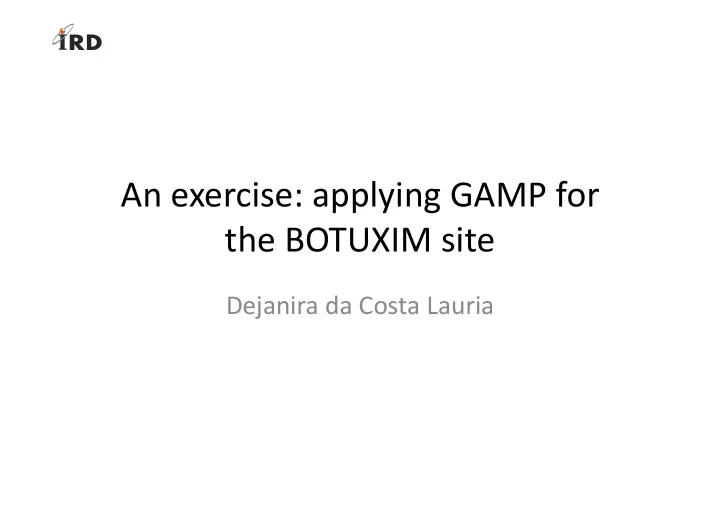

An exercise: applying GAMP for the BOTUXIM site Dejanira da Costa Lauria
IDENTIFYING THE PROBLEM
Where does the contamination come from? Monazite ore was processed, from 1945 up to July 1992, to obtain rare earth oxides. A residue containing Th and U oxide was produced ( Cake II ). Monazite 0.3% U 3 O 8 7% ThO
And…. where are the residues stored? The Botuxim site 3,500 METRIC TONS of Cake II are STORED IN 7 POOLS (SILOS) Seven pools, 3 m deep, surrounded by 30 cm thick concrete walls and floors. Each pool is 0.5 m above the soil surface and 2.5 m underground. They are capped with concrete .
Cake II: residue or waste? A mixture of 0.9 % of U 3 O 8 and 22% of ThO 2 : specific activity around 1820 Bq/g.
Botuxim site Guard well Water supply system of the Itu city
The water of the Guard well presented high concentrations of radionuclides !!! Beta concentration in some waters of the region (Bq/L)* Local N Minimum Maximum Geometric mean Guard well 77 0.01 4.00 0.30 Monjolinho 8 0.04 0.40 0.15 Creek Itu town 6 0.05 0.20 0.11 * Data supplied by CETESB Heavy rain in the rainy season seems to play a important role for the observed high concentrations of radionuclides in the Guard well water.
Previous radiological survey Area out side the silos fence • Gamma radiation survey: values Distribution of radionuclides in soil ranged from 50 to 1000 cps (1993) Ra-228: from 0.03 to 70 Bq/g Ra-226: from 0.02 to 0.9 Bq/g U-238: from 0.02 to 13 Bq/g
PRELIMINARY SITE INVESTIGATION AND CHARACTERISATION
Important features for the site Situation Topic Historical survey of the site Yes Radionuclides in soil, surface Yes (in the air it was not water, sediments and considered necessary) groundwater Physical and Chemical Not completed characteristics of contaminant; Integrity of the containing of inconclusive the wastes (the silos); Radiological criteria: 1 mSv/y Screening = clean up criteria
Exposure scenario
SCREENING ASSESSMENT
Total dose due to the highest values of radionuclide concentrations in soil DOSE: All Nuclides Summed, All Pathways Summed 0.5 0.4 0.3 0.2 0.1 0.0 0 200 400 600 800 1000 1200 Years Pb-210 Po-210 Ra-226 Ra-228 Th-228 Th-232 U-234 U-238 Total BOT SCREN-26-09.ROF 09/26/2010 12:22 Graphics.Asc Includes All Pathways Maximum value of dose: 0.44 mSv/y Parameters changed in RESRAD offsite: Volume of surface water: 300m 3 Mean residence time of water: 0.003 y
Main exposure pathways Rn-220 is the highest contributor for the dose.
Sensitivity Analysis DOSE: T h-232, All Pathways Summed With SA on Rn-220 emanation coefficient 0.9 0.8 0.7 0.6 0.5 0.4 0.3 0.2 0.1 0.0 0 200 400 600 800 1000 1200 Years Upper: .3 Mid: .15 Lower: .075 BOT SCREN-26-09.ROF 09/26/2010 13:41 Graphics.Asc Includes All Pathways Emanation of Rn-220 Varying by a factor of two, the dose also varied by a factor of 2
Effective radon diffusion coefficient of contaminated zone DOSE: T h-232, All Pathways Summed With SA on Contaminated radon diffusion coefficient 1.4 1.2 1.0 0.8 0.6 0.4 0.2 0.0 0 200 400 600 800 1000 1200 Years Upper: .00002 Mid: .000002 Lower: .0000002 BOT SCREN-26-09.ROF 09/26/2010 12:33 Graphics.Asc Includes All Pathways So, if possible these parameters should be assessed for the site!
An exercise with biota… DOSE: All Nuclides Summed, Ingestion of Fish 0.06 0.05 0.04 0.03 0.02 0.01 0.00 0 200 400 600 800 1000 1200 Years Pb-210 Po-210 Ra-226 Ra-228 Th-228 Th-232 U-234 U-238 Total BOT SCREN-26-09.ROF 09/26/2010 14:41 Graphics.Asc Pathways: Ingestion of F ish Very low value of human dose by fish ingestion
However, high level of Ra ‐ 228 in surface water CONCENT RAT ION: Ra-228, Surface water 1.6 1.4 1.2 1.0 0.8 0.6 0.4 0.2 0.0 0 200 400 600 800 1000 1200 Years BOT SCREN-26-09.ROF 09/26/2010 07:33 Graphics.Asc The estimated concentration of radionuclides in water for 0.5 year is: Ra-228=0.1 Bq/L; Th-228=Th-232=0.1 Bq/L; U- 238=U-234=0.02 Bq/L.
And…..a very high radionuclides concentration in fish CONCENT RAT ION: Ra-228, Fish 80 70 60 50 40 30 20 10 0 0 200 400 600 800 1000 1200 Years BOT SCREN-26-09.ROF 09/26/2010 07:33 Graphics.Asc The estimated concentration of radionuclides in fish for 0.5 year is: Ra-228=6.1 Bq/kg; Th-228=Th-232=30 Bq/kg; U- 238=U-234=0.22 Bq/kg
Dose for Biota ‐ Erica Tool • For at least one organism the screening dose rate is exceeded. Total Dose Rate per • Organism organism [µGy h-1] Benthic fish 763 Pelagic fish 2.3 Dose limit: Erica 10 µGy/h ; UNSCEAR, ICRP, DOE 400 µGy/h
Sediment concentration by ERICA!! Activity Concentration in sediment Isotope [Bq g-1 d.w.] Ra-228 7.6 Th-228 1840 Th-232 1840 U-234 0.0004 U-238 0.0004
Some highlights • Realistic, what does it mean realistic? • The establishment of exposure scenario is of primordial importance, specially for long ‐ lived radionuclides. The exposure pathway can change with time. In the future someone can use the sediment for building. Why not? • The use of default parameters (for screening analysis) should be followed by a sensitivity analysis, in order to avoid misunderstanding. • The sensitivity analysis (SA) points out the specific parameters that should be determined for the step of detailed assessment. • The exposure pathway for human can be very different of exposure pathway for biota. Consider to model both: human and biota; • What about to include in the final report a list with some physical parameters as e.g. hydraulic conductivity (minimum and maximum) to help user with the SA ?
GAMP….. Initial Characterization Exposure Scenario Screening modelling Human non ‐ human Sensibility Analysis (choose of parameters to be analyzed)
DETAILED ASSESSMENT
Should consider • A detailed survey of the surface and subsurface contamination; • Determination of some specific parameters: e.g. radon emanation and diffusion coefficient, residence time of the water in the creek • Validation: – Monitoring sediment – Monitoring Rn ‐ 220
THANKS FOR ATTENTION
Recommend
More recommend